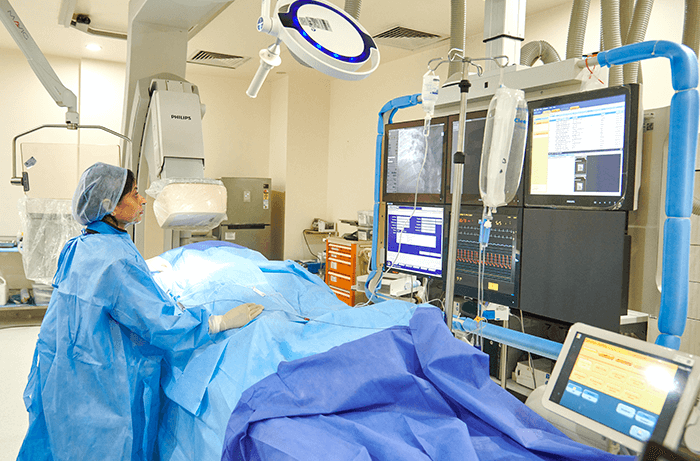×
Select Your Country
 International
International

×
Select Your Country
 International
International


Our heart is a highly complex organ and thus, the accurate diagnosis and treatment of certain compelling disorders is quite a challenging task for healthcare practitioners. Coronary artery disease occurs due to the blockage or narrowing of the coronary arteries, which is caused because of atherosclerosis, which is the build-up of fatty and inflammatory deposits called plaque on the inner walls of the arteries and cholesterol that restrict the flow of blood to the heart. Without an adequate supply of blood, oxygen and vital nutrients don’t reach the heart, thus impacting its ability to work properly. Some of the most complicated coronary artery diseases are the ones occurring in the left main coronary artery, chronic total occlusion, rotablation, and bifurcation blockage.
Left Main Coronary Artery Disease (LMCA)
The left main coronary artery acts as the primary source of blood flow to the heart’s left ventricle. In some cases, the build-up of plaque consisting of calcium, cholesterol, fats, and other substances in the coronary artery blocks the flow of blood. Severe blockage in blood flow can cause shortness of breath, chest pain or angina, or even a heart attack in some cases. However, the advent of a few path-breaking interventions is making a huge difference to the treatment of coronary artery diseases. Cardiologists frequently use intravascular ultrasound (IVUS) for diagnosing blockage or left main coronary stenosis. Complex Coronary Interventions Left Main Bifurcation Chronic Total Occlusion Rotablation in India is present at Manipal Hospitals, visit today.
Solutions for LMCA Disease
The percutaneous coronary intervention (PCI) technique with stents is a comparatively less invasive procedure, and it is conducted for treating the LMCA disease. During this procedure, a coronary artery stent, which is usually inserted during angioplasty, is a tiny, metal mesh tube that expands once it is placed inside a coronary artery. This tube prevents blockage in the artery. A drug-eluting stent is coated with medicine for preventing the closing of the artery.
In cases where angioplasty fails to clear the blockages, the coronary artery bypass graft is used. However, it is an open heart procedure and requires hospitalization. But, this procedure significantly enhances the quality of life, mitigates angina and various other coronary heart disease symptoms, improves the heart’s pumping action even if it has been already damaged by a heart attack, improves the patient’s chances of survival, and reduces the chances of a heart attack.
Coronary Bifurcation Lesion
Coronary bifurcation is one of the most complicated lesions in interventional cardiology. Stenosis or the narrowing of a main coronary artery and an adjoining side-branch vessel is called a bifurcation lesion or bifurcation blockage. Manipal is the Cardiology hospital in India providing the best treatment.
Solutions for Coronary Bifurcation
The provisional T-stent and the systematic implantation of a stent in both the side-branch vessel and the main vessel are the two major interventional strategies commonly adopted by cardiologists. Apart from the placing of the usual guide wire in the main vessel, the cardiac interventionist also inserts a second guidewire via the stent in the main vessel and conducts a ‘kissing balloon’ or side-by-side dilatation after placing the first stent.
Chronic Total Occlusion (CTO)
It is a severe type of coronary artery disease and involves complete blockage in the artery. This disease is characterized by a total coronary occlusion which is over three months old.
Solutions for CTO
At Manipal Hospitals, our experienced and expertly trained team of cardiologists is well-equipped to perform complex coronary interventions, such as angioplasty and stenting, to unclog blocked arteries. Our experts use the retrograde technique which involves accessing the total coronary blockages from collateral blood vessels. Collateral blood vessels are new blood vessels that develop to reroute the flow of blood around a blockage. These blood vessels form when the severity of an artery blockage increases.
During this procedure, two hollow thin tubes called catheters are inserted from an artery in the groin or wrist to the heart. A contrast dye is then placed inside the coronary arteries. X-ray images are used for tracing the dye as it flows through the arteries, thus assisting in detecting blockages. Then, a very fine guidewire is inserted into the blocked artery from the back (retrograde) and front (antegrade) by the cardiologist. This is followed by the inflation of the balloon inside the artery to open it up and the insertion of permanent drug-eluting stents (small mesh coils) for opening the artery and releasing medication over a while to prevent the build-up of plaque.
This highly complicated minimally invasive procedure greatly reduces the risks of heart attacks usually associated with CTO.
Rotablation
The rotablation procedure is very similar to the cardiac angiogram and employs the use of a rotablator, which is a miniature diamond-studded drill, for treating calcified lesions before an angioplasty is conducted. In this procedure, a catheter is placed into the right radial artery in the wrist or the right femoral artery in the groin. Once the wire and the catheter are in the right position, the cardiologist will utilize the rotablator to pulverize the plaque. This will be followed by the inflation of a balloon and stent in the area.